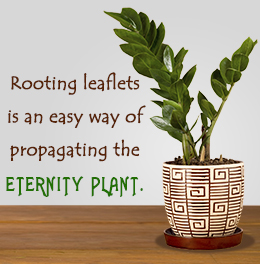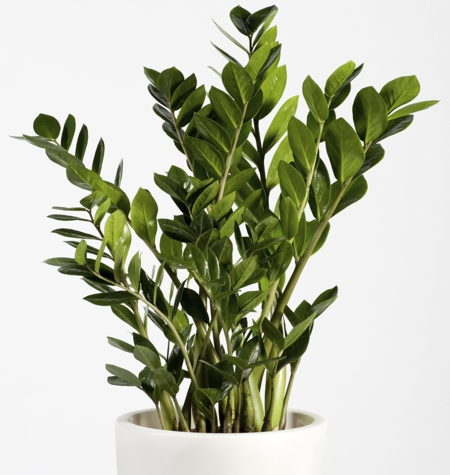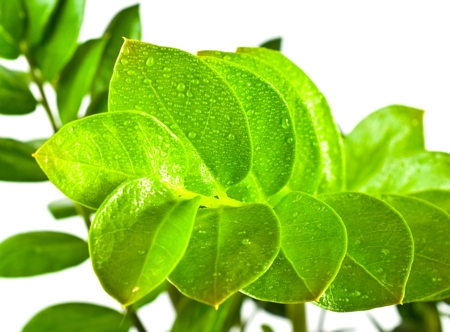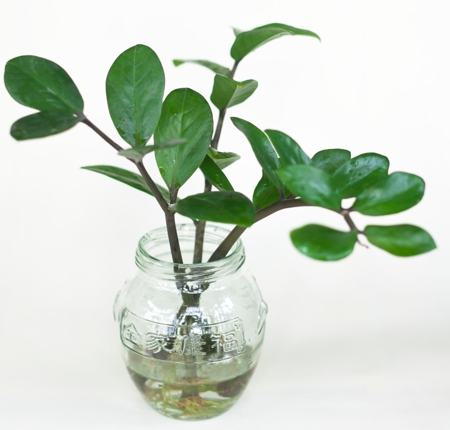If you are a novice with zero awareness about plant care, eternity plants are ideal for you. Here's a brief overview of these hardy plants.

The eternity plant is often called
'fat boy plant', and this name is derived from its fat tuberous rhizomes.The eternity plant (
Zamioculcas zamiifolia) is very popular for its glossy-green leaves and hardy nature. The plant is an aroid that belongs to the genus
Zamioculcas in the family
Araceae. So, it is called the ZZ plant, as a short form of its scientific name. The plant has other names like zee-zee plant, zulu, zanzibar gem, aroid palm, etc. Apart from its appearance, the main advantage of a ZZ plant is that, it requires very low maintenance and care.Above all, it survives low-light conditions, and is ideal for indoor locations.The eternity plant has dark-green, smooth, and glossy leaflets, that are arranged in pairs, on an axis. A single leaf may have around 6 to 8 pairs of leaflets. The plant grows from underground rhizomes, and can attain a maximum height of around 60 to 90 centimeters.The thick, waxy leaf is an adaptation that helps the plant in preventing water loss through transpiration. The plant stores water in its rhizomes too. It is because of these adaptations that the eternity plant manages to survive extreme drought conditions. The inconspicuous flowers of this plant are produced inside a spadix that can be yellowish-brown to bronze in color. The spadix is found near the base of the plant, often hidden among the leaves. This plant blooms during late summer or early fall.ZZ Plant Care Instructions

The eternity plant is not at all fussy, and it can survive the most adverse conditions. In fact, you can keep this plant in a dark corner of the room and conveniently forget to water it for weeks, and even months. The plant will remain live, though not in good health. Though it can survive adverse conditions, it will not grow till its basic requirements are satisfied. It may happen that the plant remains inactive for a very long time, without producing even a single leaf.Given below are some tips and guidelines for growing the eternity plant in a proper manner.Soil and Light Requirement➽ Eternity plants need a well-drained soil or potting mix. You can also use a mixture of cactus potting mix and perlite, in equal parts. The ideal pH range is between 5.6 to 7.5.
➽ These plants thrive well in bright to moderate, indirect light. Filtered sun or direct morning sun may also work if the plant is grown in very hot locations. Plants grown in cooler regions may tolerate the morning as well as afternoon sun. However, the harsh afternoon sun has to be avoided.Watering and Feeding➽ Though it may survive without light to a certain extent, bright light is necessary if you want it to grow and produce leaves. It is better not to water the plant, rather than killing it with over-watering. Excess water may cause root rot, with symptoms like yellowing of leaves. Indoor plants require less water when compared to the outdoor ones. Water these plants only when the soil gets dry.➽ In case of root rot, you have to remove the plant from the container and discard the soil or potting mix. Remove soft and mushy rhizomes, along with other infected parts and yellow leaves. The container has to be sterilized and filled with a new potting medium, before repotting the plant. It is advisable to apply a fungicidal solution on the rhizomes before planting.
➽ Feeding is not necessary for eternity plants, especially those growing on the ground. However, once-a-month light feeding may prove beneficial. It is better to feed during the time of active growthHumidity and Temperature➽ The eternity plant has no preferred humidity level. However, a temperature range of 70 to 85ºF is believed to be ideal. It must not go below 60ºF or beyond 90ºF. The plant may not tolerate very low temperatures, and is ideal for hardiness zones 9a to 11.Eternity plants are not prone to pests and diseases. Being slow-growing plants, usually, repotting is not necessary. If they grow really big, repotting can be done during spring. These plants need not be pruned, but dead and damaged leaves, and yellow leaflets can be removed.Eternity Plant PropagationPropagation of ZZ plants is not a difficult task. All you need to do is root stem cuttings or leaflets, or divide the root mass. Division of root mass can be done only if the plants are large with three to four tubers. This is the fastest method of ZZ plant propagation. Those with smaller specimens can try rooting of leaf cuttings, which is the easiest method for propagating eternity plants.

Leaves of the eternity plant➽ Take a few leaflets and plant them in a tray filled with well-draining potting medium or soil. Water the medium and place the tray in a bright, warm spot.
➽ While planting the leaflet, make sure that the cut end goes down, along with a small part of the leaflet. A major portion of the leaflet must be out of the soil so that photosynthesis takes place, thereby leading to the growth of roots and tubers.➽ It takes around six months for the leaflets to develop tubers. By this time, the leaflets may wither, but the tubers remain live and produce shoots within 12 to 15 months.
➽ If the leaflets dry out within a few days of planting, you have to repeat the process once again (provided you have enough leaves in the plant).➽ Eternity plant leaflets can also be grown in water, instead of soil. Even stem cuttings will produce roots in water. For this purpose, you have to immerse the base of the leaflets or stem cuttings in water. Transplantation can be done when they develop roots and tubers.
Eternity plants can be expensive. So, you can resort to these methods of propagation if you want to enhance your collection of eternity plants. The only drawback is that the whole process is time-consuming.

Eternity plant stem cuttings growing in waterAs the name rightly suggests, the ZZ plant is truly eternal, as it can survive without light and water for a longer time as compared to many other plants. It is highly popular for its glossy leaves that look freshly polished. So, eternity plants do not need leaf shiners. Almost all parts of the plant are believed to be toxic, if ingested in large amounts. Therefore, keep kids and pets away.






 The eternity plant is often called 'fat boy plant', and this name is derived from its fat tuberous rhizomes.The eternity plant (Zamioculcas zamiifolia) is very popular for its glossy-green leaves and hardy nature. The plant is an aroid that belongs to the genus Zamioculcas in the family Araceae. So, it is called the ZZ plant, as a short form of its scientific name. The plant has other names like zee-zee plant, zulu, zanzibar gem, aroid palm, etc. Apart from its appearance, the main advantage of a ZZ plant is that, it requires very low maintenance and care.Above all, it survives low-light conditions, and is ideal for indoor locations.The eternity plant has dark-green, smooth, and glossy leaflets, that are arranged in pairs, on an axis. A single leaf may have around 6 to 8 pairs of leaflets. The plant grows from underground rhizomes, and can attain a maximum height of around 60 to 90 centimeters.The thick, waxy leaf is an adaptation that helps the plant in preventing water loss through transpiration. The plant stores water in its rhizomes too. It is because of these adaptations that the eternity plant manages to survive extreme drought conditions. The inconspicuous flowers of this plant are produced inside a spadix that can be yellowish-brown to bronze in color. The spadix is found near the base of the plant, often hidden among the leaves. This plant blooms during late summer or early fall.ZZ Plant Care Instructions
The eternity plant is often called 'fat boy plant', and this name is derived from its fat tuberous rhizomes.The eternity plant (Zamioculcas zamiifolia) is very popular for its glossy-green leaves and hardy nature. The plant is an aroid that belongs to the genus Zamioculcas in the family Araceae. So, it is called the ZZ plant, as a short form of its scientific name. The plant has other names like zee-zee plant, zulu, zanzibar gem, aroid palm, etc. Apart from its appearance, the main advantage of a ZZ plant is that, it requires very low maintenance and care.Above all, it survives low-light conditions, and is ideal for indoor locations.The eternity plant has dark-green, smooth, and glossy leaflets, that are arranged in pairs, on an axis. A single leaf may have around 6 to 8 pairs of leaflets. The plant grows from underground rhizomes, and can attain a maximum height of around 60 to 90 centimeters.The thick, waxy leaf is an adaptation that helps the plant in preventing water loss through transpiration. The plant stores water in its rhizomes too. It is because of these adaptations that the eternity plant manages to survive extreme drought conditions. The inconspicuous flowers of this plant are produced inside a spadix that can be yellowish-brown to bronze in color. The spadix is found near the base of the plant, often hidden among the leaves. This plant blooms during late summer or early fall.ZZ Plant Care Instructions The eternity plant is not at all fussy, and it can survive the most adverse conditions. In fact, you can keep this plant in a dark corner of the room and conveniently forget to water it for weeks, and even months. The plant will remain live, though not in good health. Though it can survive adverse conditions, it will not grow till its basic requirements are satisfied. It may happen that the plant remains inactive for a very long time, without producing even a single leaf.Given below are some tips and guidelines for growing the eternity plant in a proper manner.Soil and Light Requirement➽ Eternity plants need a well-drained soil or potting mix. You can also use a mixture of cactus potting mix and perlite, in equal parts. The ideal pH range is between 5.6 to 7.5.
The eternity plant is not at all fussy, and it can survive the most adverse conditions. In fact, you can keep this plant in a dark corner of the room and conveniently forget to water it for weeks, and even months. The plant will remain live, though not in good health. Though it can survive adverse conditions, it will not grow till its basic requirements are satisfied. It may happen that the plant remains inactive for a very long time, without producing even a single leaf.Given below are some tips and guidelines for growing the eternity plant in a proper manner.Soil and Light Requirement➽ Eternity plants need a well-drained soil or potting mix. You can also use a mixture of cactus potting mix and perlite, in equal parts. The ideal pH range is between 5.6 to 7.5. Leaves of the eternity plant➽ Take a few leaflets and plant them in a tray filled with well-draining potting medium or soil. Water the medium and place the tray in a bright, warm spot.
Leaves of the eternity plant➽ Take a few leaflets and plant them in a tray filled with well-draining potting medium or soil. Water the medium and place the tray in a bright, warm spot. Eternity plant stem cuttings growing in waterAs the name rightly suggests, the ZZ plant is truly eternal, as it can survive without light and water for a longer time as compared to many other plants. It is highly popular for its glossy leaves that look freshly polished. So, eternity plants do not need leaf shiners. Almost all parts of the plant are believed to be toxic, if ingested in large amounts. Therefore, keep kids and pets away.
Eternity plant stem cuttings growing in waterAs the name rightly suggests, the ZZ plant is truly eternal, as it can survive without light and water for a longer time as compared to many other plants. It is highly popular for its glossy leaves that look freshly polished. So, eternity plants do not need leaf shiners. Almost all parts of the plant are believed to be toxic, if ingested in large amounts. Therefore, keep kids and pets away.